Q.
Why are so many Americans, Canadians and Europeans
flocking to Costa Rica to buy property?
A.
Costa Rica is a safe, stable country with a stable
government and a thriving economy. It has a tropical
climate and beautiful beaches and scenery. Property
is affordable and appreciating rapidly. Finally,
the government has made a sincere effort
to encourage foreign investment.
Q.
Can a non-Costa Rican purchase and own property
in Costa Rica?
A. Yes, a foreigner has the
same rights to own property in Costa Rica as do
citizens. The ownership rights are guaranteed by
the Costa Rican constitution and apply regardless
of whether the property is placed in the name of
a corporation or in the name of an individual. Citizenship,
residence and presence in the country is not required
for land ownership.
Q.
Do I need to use a realtor or broker to buy property
in Costa Rica?
A. If you are buying property
in Costa Rica, you should enlist a reputable real
estate company. Choosing a good agent will help
you find the property that is right for you and
ensure the purchase process is conducted properly.

Q.
How is title transferred?
A. When buying Costa Rican
property, title is transferred from seller to buyer
by executing a transfer deed (escritura) before
a public notary. Unlike the United States and Canada,
where the role of the notary is limited to authenticating
signatures, in Costa Rica the notary has extensive
power to act on behalf of the state. The notary
must be an attorney and may draft and interpret
legal documents, as well as certify the authenticity
of documents.
Once
a transfer deed is accepted for registration, the
Public Registry will return the original document
with all the necessary stamps.
Q.
How much are the closing costs?
A. The general custom in Costa Rica is for the seller
and buyer to share equally in the closing costs.
This can be altered by agreement and typically depends
on the particular transaction. Closing costs containing
the notary fees are, based on the real sales price,
1.5% from the first one million Colones, the local
currency, and 1.25% on the balance.
In
addition, buyers need to anticipate land transfer
tax, legal fees, and other fees of around about
2.56% of the declared value of the property.
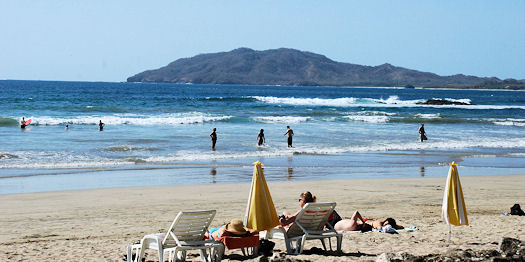
Q.
How much are property taxes in Costa Rica?
A.
Property taxes (municipal tax) throughout Costa
Rica are very low when compared to the North American
countries or Europe. The municipal tax is applied
at the municipal level and varies throughout the
country. Paid quarterly, the property type, location
and other factors contribute to the calculation
of this tax.
The
real estate tax is based on the declared value of
the property. This tax is applicable throughout
the country regardless of the property's location
and payable when transferring title.
Q.
Do foreign buyers have to pay capital gains tax
in two countries - their native country and Costa
Rica?
A. A nice incentive for foreign investors is that
Costa Rica has no capital gains tax. The Costa Rican
government will not tax property owners on their
profit from the sale of their property as long as
this is not undertaken as a means of business. However,
foreign buyers would be obligated to pay taxes on
any declared earnings being brought back to their
country of citizenship.
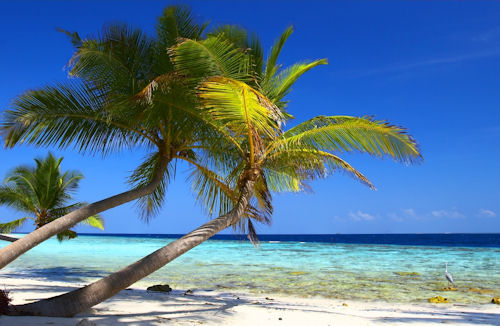
Q.
Who pays the sales commission?
A. Typically, the seller or owner pays the commission
to the realtor or broker at closing. The buyer does
not have to pay any commission when buying property
in Costa Rica, unless he specifically agrees to
do so as part of the transaction.
Q.
How can a foreign buyer ensure that he has clear
title to the property?
A. To ensure clear title, it's important that the
necessary steps are taken to properly register the
property, and more importantly, be assured that
the property in question is free of all liens.
The
Registro de la Propiedad (Property Registry) is
located in San Jose - Zapote, 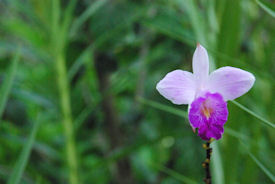 where all property
documents are recorded. A title search at the Registry
would confirm good title and proper ownership. In
the event that adjustments were made to any given
title, these alterations must have been recorded
at the Registry.
where all property
documents are recorded. A title search at the Registry
would confirm good title and proper ownership. In
the event that adjustments were made to any given
title, these alterations must have been recorded
at the Registry.
The
Public Registry report (informe registral) provides
detailed information on the property, including
the name of the title holder, boundary lines, tax
appraisal, liens, mortgages, recorded easements,
and other recorded instruments that would affect
title. Title insurance further ensures that a real
estate purchase can be fully secured.
Q. Do foreign buyers need an
address in Costa Rica to purchase a property?
A. No, it is not necessary to have established residency
to buy property in Costa Rica. Foreigners can buy
property with a tourist status visa. Living in Costa
Rica, however, is another matter. Foreigners and
tourists have to leave the country for 72 hours
once every three months in order to renew their
legal status in Costa Rica.
Some
of the foreigners without residency travel throughout
Nicaragua or Panama for a couple of days to discover
more of Central America and to renew their visa.
Q.
Are there regulations regarding beachfront properties?
A. When buying property located on Costa Rica's
beaches, buyers should be aware of the following:
building a home adjoining beach areas falls under
a category known as the Maritime Zone Law, the first
200 meters of land measured from the high tide line.
The
first 50 meters from the mean high tide mark cannot
legally be built on by anybody, as it is considered
public beach. From that point, the next 150 meters
is restricted and subject to the Maritime Zone Law.
It cannot have an "original title," but
can be leased by a concession from the local municipality.
General
Information About Costa Rica
Q.
Where is Costa Rica?
A. Costa Rica borders both the Caribbean Sea (to
the east) and the North Pacific Ocean (to the west),
with a total of 802 miles of coastline (132 miles
on the Caribbean coast and 631 miles on the Pacific).
It is about the size of West Virginia.
Costa Rica also borders Nicaragua to the north and
Panama to the south-southeast (397 mi of border).
In total, Costa Rica comprises 19,730 sq. miles.
It also includes several islands. Among them are
Cocos Island and Calero Island.
Q. How is Costa Rica divided
up?
A. Costa Rica is comprised of seven provinces, which
in turn are divided into 81 districts ("cantón"
in Spanish, plural "cantones"), each directed
by a mayor. Mayors are chosen democratically every
four years by each canton's people. There are no
provincial legislatures.
Q. Where did Costa Rica get
its name?
A. Costa Rica means Rich Coast. Technically the
country could be called "Costas Rica,"
or Rich Coasts simply because it has two coasts:
one on the Pacific Ocean and the other on the Caribbean
Sea.
Q. Are these two coasts the
same?
A. The two coasts are physically as different from
each other as are the Atlantic and Pacific coasts
of North America.
Q.
What is the Pacific Coast like?
A. The Pacific coast has a rugged (although mostly
accessible) coastline where forested mountains often
meet the sea. The area can be divided into three
distinct regions - Guanacaste and the Nicoya Peninsula;
the Central Coast; and finally the Southern Coast.
There
are some spectacular stretches of coastline, and
most of the country's top beaches are on the Southern
Coast. The coast varies from the dry, sunny climate
of the northwest to the hot, humid rainforests of
the south.
Q. What is the Caribbean Coast
like?
A. The Caribbean Coast can be divided into two areas.
The remote northeast coastline is a vast flat plain
laced with rivers and covered with rain forest.
Farther south, along the stretch of coast accessible
by car, there are uncrowded beaches and even a bit
of coral reef.

Q. Where is Costa Rica located?
A. Costa Rica is in the middle of Central America.
It is bordered by Nicaragua to the north and Panama
to the southeast. The country is only slightly larger
than Vermont and New Hampshire combined.
Q. What is the interior of
the country like?
A. Much of the country is mountainous, with three
major ranges running northwest to
southeast. Among these mountains are several volcanic
peaks, some of which are still active. Between the
mountain ranges are fertile valleys, the largest
and most populated of which is the Central Valley.
Q. What is the weather like?
A. With the exception of the dry Guanacaste region,
much of Costa Rica's coastal area is hot and humid
and covered with dense rainforests.
Q. What about the Central Valley
and San Jose?
A. The Central Valley is characterized by rolling
green hills that rise to heights between 2,900 and
4,000 feet above sea level. The climate here is
mild and spring-like year-round. For that reason,
it's Costa Rica's primary agricultural region, with
coffee farms making up the majority of land holdings.
The rich volcanic soil of this region makes it ideal
for farming.
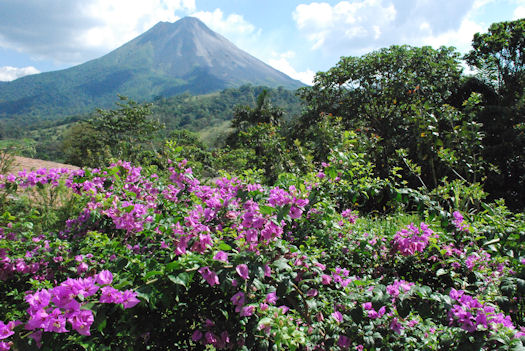
The
country's earliest settlements were in this area,
and today the Central Valley (which includes San
Jose) is densely populated with decent roads, and
dotted with small towns.
Many
of the mountainous regions to the north and to the
south of the capital of San Jose have been declared
national parks (Tapanti, Juan Castro, and Braulio
Carrillo) to protect their virgin rainforest against
logging.
Q. What is the Guanacaste and
the Nicoya Peninsula area like?
A. This region is in the northwestern corner of
the country near the Nicaraguan border. It is the
site of many of Costa Rica's sunniest and most popular
beaches. Many Americans have chosen to build beach
houses and retirement homes here.
Now
that the new international airport in Liberia is
up and running, travelers can get to this region
on daily direct flights from North America.
Q. What is the weather like
in the Guanacaste area?
A.
With about 65 inches of rain a year, this region
is by far the driest in the country and comparable
to west Texas.
Q. What documents are required
to enter Costa Rica?
A. Citizens of the United States, Canada, Great
Britain, and most European nations may visit Costa
Rica for a maximum of 90 days. No visa is necessary
but visitors should have a valid passport.
Q. What currency is used in
Costa Rica?
A. The unit of currency in Costa Rica is the colon.
The colon is divided into 100 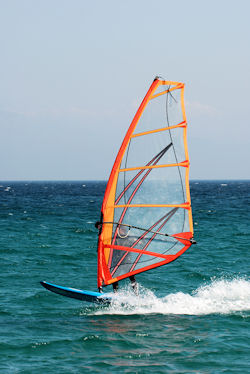 centimos. Foreigners
can exchange money at all state-owned banks. ATMs
are quite common throughout Costa Rica, particularly
in San Jose, and at most major tourist destinations
around the country.
centimos. Foreigners
can exchange money at all state-owned banks. ATMs
are quite common throughout Costa Rica, particularly
in San Jose, and at most major tourist destinations
around the country.
Q. When is the best time to
visit Costa Rica?
A. Costa Rica's high season for tourism runs from
late November to late April, which coincides almost
perfectly with the chill of winter in the U.S.,
Canada, and Great Britain. The high season is also
the dry season. Christmas holidays are when the
tourism industry operates at full tilt.
Q.
When are the rainy and dry seasons?
A.
Generally, the rainy season (or green season) is
from May to mid-November. Costa Ricans call this
wet time of year their winter.
The
dry season, commonly referred to as summer by residents
of Costa Rica, is from mid-November to April. In
Guanacaste, the dry northwestern province, the dry
season lasts several weeks longer than in other
places.
Q. What are the important holidays
in Costa Rica?
A. Because Costa Rica is a Roman Catholic country,
most of its holidays are church-related. The big
holidays include Christmas, New Year's, and Easter,
which are all celebrated for several days.
Q. Is air travel available
to Costa Rica?
A. It takes between 3 and 7 hours to fly to Costa
Rica from most U.S. cities. As Costa Rica becomes
more popular with North American travelers, more
flights will become available into San Jose's Juan
Santamaria International Airport.
In
addition, Delta, American, US Airways, United and
Continental all have regular non-stop commercial
flights to the international airport in Liberia
from their hubs in Atlanta, Miami, Charlotte, Chicago,
and Houston.
Flying
is one of the best ways to get around Costa Rica.
Because the country is quite small, flights are
short and relatively inexpensive.
Liberia
is the gateway to the beaches of the Guanacaste
region and the Nicoya Peninsula.
Q. Do the cruise lines go to
Costa Rica?
A. More than 150 cruise ships dock each year in
Costa Rica, calling at Limon on the Caribbean coast,
and at Puerto Caldera and Puntarenas on the Pacific
coast.
Q. What makes Costa Rica so
attractive to visit?
A. Costa Rica is a rich and varied destination with
numerous natural attractions and a broad selection
of exciting sight, scenery, adventure activities,
and ecosystems. On a trip to Costa Rica, visitors
can see rainforests, cloud forests, active volcanoes
and miles of beautiful beaches on both the Pacific
and Caribbean coasts.
Costa
Rica has 26 national parks, protecting more than
11% of the country. Many of these national parks
are undeveloped tropical forests. Costa Rica is
also a relatively compact country, which makes visiting
several destinations during a single vacation both
easy and enjoyable.
Q.
Why is Costa Rica known for its ecology?
A. Costa Rica is home to a rich variety of plants
and animals. It is world renowned for its bio-diversity.
Over 25% of Costa Rica is composed of protected
forests and reserves.
Q. What is the capital of Costa
Rica?
A. San Jose is the country's capital and the most
cosmopolitan city in Central America. Costa Rica's
stable government and the Central Valley's climate
have, over the years, attracted people from all
over the world. There is a large diplomatic and
international business presence here. The pleasant
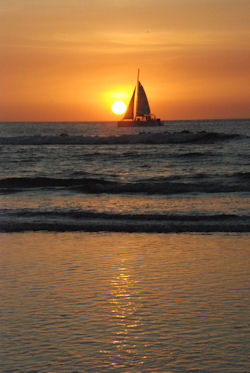 climate along with the beautiful view of lush green
mountainsides, make San Jose a memorable city to
visit.
climate along with the beautiful view of lush green
mountainsides, make San Jose a memorable city to
visit.
San
Jose was built on the profits of the coffee-export
business. Costa Rica's climate, and specifically
the climate of the Central Valley, is ideally suited
to grow coffee.
Q.
What are some other areas in Costa Rica that are
popular with natives and foreigners?
A. Located just about 15 minutes west
of San Jose and about the same distance from the
international airport are the affluent suburbs of
Escazu and Santa Ana, each of which has experienced
rapid growth in recent years as the metropolitan
area continues it urban sprawl.
Both
Escazu and Santa Ana are popular with the Cost Rican
professional class and North American retirees and
expatriates.
Q. What is Costa Rica's population?
A. In 2005, Costa Rica had an estimated population
of 4.43 million people. The majority of Costa Ricans
are of Spanish ancestry or descended from a mixture
of indigenous and Spanish ancestors.
Q. Is Costa Rica a stable country?
A. Costa Rica is, and has historically been, a sea
of tranquility in a region that has been troubled
by turmoil for centuries. For more than 100 years,
it has enjoyed a stable democracy and a relatively
high standard of living for Latin America.
The
literacy rate is high, as are medical standards
and facilities. Perhaps, most significant, at least
for proud Costa Ricans, is that this country does
not have an army.
Q. What is Costa Rica's relationship
with the United States?
A. The United States and Costa Rica have a history
of friendly relations based on respect for democratic
government, free trade, and other shared values.
Costa Rica generally supports the U.S. in international
forums, especially in the areas of democracy and
human rights.
The United States is Costa Rica's most important
trading partner. The U.S. accounts for almost half
of Costa Rica's exports, imports, and tourism, and
more than two-thirds of its foreign investment.
The two countries share growing concerns for the
environment and want to preserve Costa Rica's important
tropical resources and prevent environmental degradation.
Q.
What are Costa Rica's natural resources?
A. Costa Rica's major economic resources are its
fertile land and frequent rainfall, its well-educated
population, and its location in the Central American
isthmus, which provides easy access to North and
South American markets and direct ocean access to
the European and Asian Continents.

One-fourth of Costa Rica's land is dedicated to
national forests, often adjoining picturesque beaches,
which has made the country a popular destination
for affluent retirees and eco-tourists.
Q. How does Costa Rica fare
economically?
A. Costa Rica used to be known principally as a
producer of bananas and coffee, but
pineapples have surpassed coffee as the number two
agricultural export.
In recent years, Costa Rica has successfully attracted
important investments by such companies as Intel
Corporation, which employs nearly 2,000 people at
its $300 million microprocessor plant; Proctor and
Gamble, which employs nearly 1,000 people in its
administrative center for the Western Hemisphere;
and Hospira and Baxter Healthcare from the health
care products industry.
Manufacturing and industry's contribution to GDP
overtook agriculture over the course of the 1990s,
led by foreign investment in Costa Rica's free trade
zone. Well over half of that investment has come
from the United States. Dole and Chiquita have a
large presence in the banana and pineapple industries.
Two-way trade between the U.S. and Costa Rica exceeded
$7.9 billion in 2006.
Are
you interested in purchasing a second home in Costa
Rica? To see what's available, visit our
Featured
Properties of Costa Rica.
*
The information above is general background about
purchasing property in Costa Rica and is not meant
as a substitute for the advice of your attorney
or accountant, who can take into consideration your
individual situation